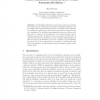Free Online Productivity Tools
i2Speak
i2Symbol
i2OCR
iTex2Img
iWeb2Print
iWeb2Shot
i2Type
iPdf2Split
iPdf2Merge
i2Bopomofo
i2Arabic
i2Style
i2Image
i2PDF
iLatex2Rtf
Sci2ools
ACRI
2006
Springer
2006
Springer
Parallel Simulation of Asynchronous Cellular Automata Evolution
For simulating physical and chemical processes on molecular level asynchronous cellular automata with probabilistic transition rules are widely used being sometimes referred to as Monte-Carlo methods. The simulation requires huge cellular space and millions of iterative steps for obtaining the CA evolution representing the real scene of the process. This may be achieved by allocating the CA evolution program onto a multiprocessor system. As distinct from the synchronous CAs which is extremely efficient, the asynchronous case of parallel implementation is stiff. To improve the situation we propose a method for approximating asynchronous CA by a superposition of a number of synchronous ones, each being applied to locally separated blocks forming a partition of the cellular array.
Related Content
| Added | 13 Jun 2010 |
| Updated | 13 Jun 2010 |
| Type | Conference |
| Year | 2006 |
| Where | ACRI |
| Authors | Olga L. Bandman |
Comments (0)

